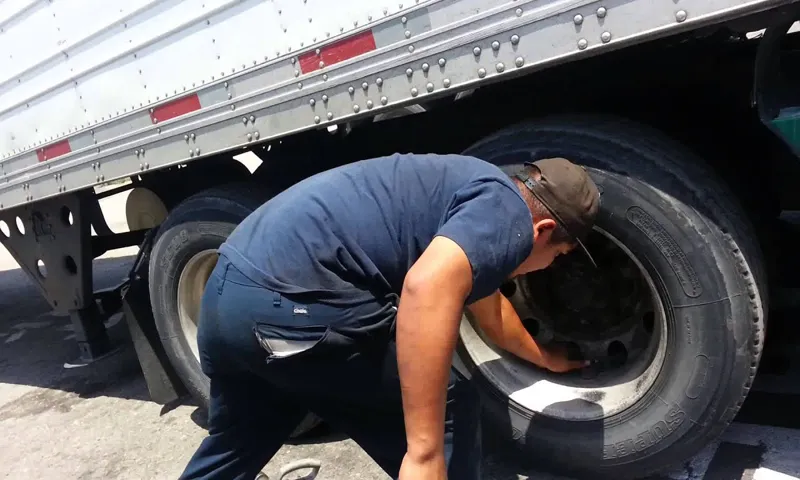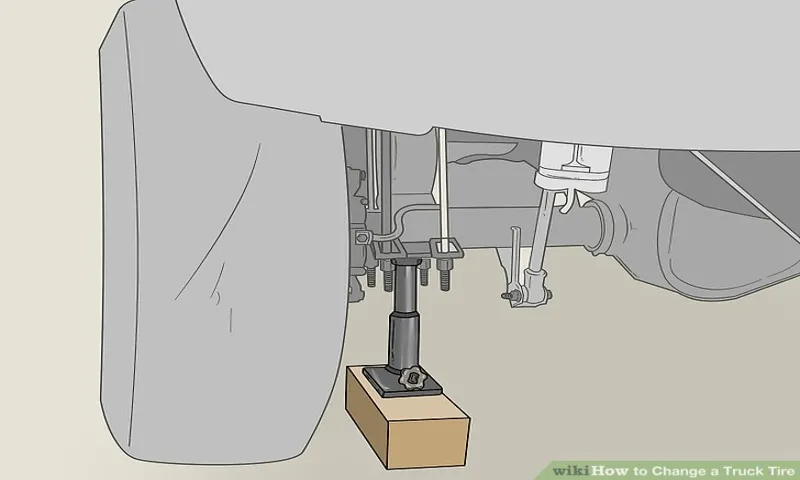Getting stuck on the side of the road with a flat tire can be a frustrating experience. However, knowing how to change a tire can save you both time and money. If you own a truck, the process of changing a tire may not differ much from changing a regular car tire, but some steps require additional attention.
In this comprehensive guide, we will walk you through the process of changing a truck tire step by step. From ensuring safety measures are taken before beginning to the final check of the replaced tire, we’ll cover everything you need to know to change a truck tire effectively. So, whether you’re a truck owner or just curious about the process, get ready to learn how to change a truck tire like a pro.
Table of Contents
Safety First
Changing a truck tire can be daunting but with the right tools and knowledge, it can be done safely and efficiently. The first step is to find a safe spot to change your tire away from traffic. Then, engage the parking brake and place a wheel wedge behind the opposite tire to prevent any movement.
Loosen the lug nuts with a lug wrench prior to raising the vehicle with a jack. Raise the vehicle high enough to remove the flat tire and replace it with the spare tire. Tighten the lug nuts in a star pattern, lowering the vehicle and re-tightening the nuts again before driving.
It’s important to regularly check the air pressure of your spare tire and replace it as soon as possible with a new tire. Safety should always come first, so if you’re unsure or need assistance, call for professional help. In summary, changing a truck tire requires preparation, the proper tools, and caution to ensure safety on the road.
Park safely and turn on hazard lights
When you’re out on the road, it’s important to remember that safety always comes first. One of the most critical aspects of staying safe is proper parking. Always make sure to park in a designated area or a safe spot on the side of the road.
Once you’ve found a safe spot, it’s time to turn on your hazard lights. By turning on your hazards, you’re alerting other drivers that your vehicle is stationary and a potential obstacle on the road. This helps to prevent accidents and increases the visibility of your vehicle.
Remember, parking and turning on your hazard lights are simple actions that can make a big difference in keeping yourself and others safe while driving. So, make it a habit to park safely and turn on your hazard lights every time you need to stop your vehicle. Safety first, always.

Use tire wedges and engage emergency brake
As a driver, safety should always be your top priority. Before stepping out of your vehicle, make sure to use tire wedges to prevent it from rolling and engage the emergency brake. These two simple steps are essential in ensuring your vehicle remains stationary and avoids any unwanted movements.
Having your car unexpectedly move when you’re not in it can be dangerous, causing potential damage to your vehicle or even causing harm to nearby people or objects. Not to mention, it can be a huge inconvenience to have to chase after your rolling car! Think of tire wedges and emergency brakes as your vehicle’s own personal safety devices, keeping it securely in place until you’re ready to return to it. By taking these extra precautions, you’re not only protecting yourself but also those around you.
So next time, remember to always put safety first and use tire wedges and engage your emergency brake before exiting your car.
Ensure adequate ventilation and avoid smoking
When it comes to ensuring safety in your home, proper ventilation and avoiding smoking are crucial factors to consider. Adequate ventilation allows for the circulation of fresh air and reduces the concentration of harmful pollutants in your indoor environment. This is especially important if your home has appliances that produce carbon monoxide, such as gas stoves or furnaces.
Make sure that your home has proper ventilation and that air filters are changed regularly to ensure optimal air quality. Smoking indoors should be avoided at all times. Cigarette smoke contains harmful chemicals that can pose health threats to you and your loved ones, including increased risks of cancer and respiratory issues.
If you’re a smoker, it’s best to step outside and smoke away from the home to minimize indoor exposure. Remember, taking the necessary precautions can help keep you and your family safe and healthy.
Gather Necessary Tools and Supplies
Changing a tire on a truck can be an intimidating task, especially for someone who has never done it before. However, with the right tools and supplies, it can be a relatively simple process. First, gather all of the necessary supplies, including a jack, lug wrench, spare tire, and any other tools specific to your vehicle.
These items should be kept in your truck at all times, so make sure they are readily available when you need them. Once you have your supplies, locate the flat tire and park your truck on level ground. It’s important to make sure your truck is parked safely before attempting to change a tire.
Taking the time to gather your tools and supplies and properly prepare your truck will make the process of changing a tire much easier and safer, helping you get back on the road in no time.
Jack stand, lug wrench, spare tire, and gloves
Changing a flat tire can be a real pain, but it helps to gather the necessary tools and supplies beforehand to make the process go as smoothly as possible. Some essential items to have on hand include a jack stand, lug wrench, spare tire, and gloves. The jack stand will lift the car off the ground so that you can remove the wheel, while the lug wrench will loosen and tighten the lug nuts.
A spare tire is crucial in case you encounter a flat while driving, and gloves will provide protection and keep your hands clean. It’s important to make sure that your spare tire is properly inflated and in good condition, as well. By having all of these tools and supplies at the ready, you’ll be better equipped to handle a flat tire emergency if it arises.
Just remember to always exercise caution and safety when changing a tire on the side of the road.
Flashlight and reflective vest for night time or low visibility conditions
When planning a night ride, it’s important to gather all the necessary tools and supplies to ensure it’s a safe and enjoyable experience. One of the most crucial items to have on hand is a flashlight. This can come in handy for navigating dark roads or paths, as well as for signaling to other riders or vehicles.
A reflective vest is also a must-have, as it can improve visibility in low light conditions. This piece of gear is particularly important for riders who may need to cross streets, as it can help alert drivers to their presence. When choosing a vest, look for one that is lightweight and breathable, so it can be worn comfortably for extended periods of time.
Together, a flashlight and reflective vest can greatly improve safety and peace of mind during night rides.
Locate the Flat Tire and Prepare the Vehicle
Changing a truck tire can be intimidating for some people, but it’s not as difficult as it seems! First, you need to locate the flat tire. Look for any visible punctures or cuts on the tire’s surface, and listen for a hissing sound indicating that air is escaping. Once you’ve identified the flat tire, park the truck on level ground and turn on the hazard lights.
Then, use a lug wrench to loosen the wheel’s lug nuts, but don’t remove them just yet. Before jacking up the truck, place a wheel chock behind one of the other tires to prevent it from rolling, and use the jack to lift the truck until the flat tire is about 6 inches off the ground. Once you’re sure that the truck is safely elevated, remove the lug nuts and slide the flat tire off the wheel studs.
Finally, place the spare tire onto the wheel studs and tighten the lug nuts by hand before lowering the truck and using the lug wrench to finish tightening the nuts. Voila! You’re ready to hit the road again. Remember, safety first and always double-check your work.
Survey the tire and remove debris if present
One of the first steps in changing a flat tire is locating the flat and preparing the vehicle. Before anything else, it’s essential to survey the flat tire and remove any debris if present. Be sure to visually inspect the tire for any punctures or damage to the sidewall.
Once you’ve assessed the condition of the tire, you can then move on to the next step. As you prepare the vehicle, ensure that it’s parked on a level surface and turn on the hazard lights to alert other drivers that you’re changing a tire. It’s also important to engage the emergency brake to prevent the vehicle from rolling while you work.
Taking the necessary precautions will make changing a tire much safer and efficient. Remember, always keep an eye on your safety and the safety of others while working on a vehicle.
Loosen the lug nuts on the flat tire
When you experience a flat tire, there are important steps you need to follow to ensure a safe repair. The first step is to locate where the flat tire is on your vehicle, usually by visually inspecting each tire. Once you have found the flat tire, it’s crucial to prepare your vehicle properly before making any repairs.
Before lifting the vehicle, you must loosen the lug nuts on the flat tire. This will help make the tire removal process easier and smoother. You can use a lug wrench or a tire iron to loosen the nuts going counterclockwise.
It’s important to only loosen them and not take them completely off just yet. Once the lug nuts are loosened, you can proceed to lift the vehicle using a jack. Remember to consult your vehicle owner’s manual before jacking up your car to ensure you’re doing it properly.
By doing these preliminary steps correctly, you can ensure a safer and more efficient tire repair.
Use the jack to lift the vehicle off the ground
When you encounter a flat tire, the first step is to locate it and prepare the vehicle. Start by finding a safe and level surface to park the car. Once you have done this, use the jack to lift the vehicle off the ground.
The jack should be placed under a sturdy part of the car, such as the frame or axle. It’s important to check the owner’s manual for the proper locations to use the jack. Use the wrench to loosen the lug nuts, but don’t remove them just yet.
Turning them counterclockwise will get them loose, but not enough to take them off. This is because you want to remove the tire once the vehicle is off the ground so that it doesn’t spin when you try to loosen the lug nuts. Always keep safety in mind and be cautious when working with a flat tire.
With these steps in mind, you should be ready to change the tire and get back on the road in no time!
Remove the Flat Tire and Install the Spare Tire
Changing a truck tire might seem like a daunting task, but with a little know-how, it can be a pretty straightforward process. First, make sure the vehicle is parked safely and on level ground. Next, loosen the lug nuts on the flat tire with a lug wrench, but don’t remove them completely just yet.
Use a sturdy jack to lift the vehicle until the flat tire is at least six inches off the ground. Once the flat tire is off the ground, unscrew the lug nuts and carefully remove the flat tire. Install the spare tire and use the lug wrench to tighten the lug nuts, but not too tight.
Lower the vehicle back to the ground and check the lug nuts again to make sure they are secure. Voila! You’ve successfully changed a truck tire. Just remember to get the flat tire repaired or replaced soon, as spare tires are only temporary solutions.
Finish removing the lug nuts and remove the flat tire
Now that you’ve loosened the lug nuts, it’s time to remove the flat tire. Give it a gentle tug, and if it’s stuck, carefully wedge a flat tool or your foot between the tire and the ground to loosen it. Once it’s free, set it aside and avoid brushing against or touching the hub to avoid any injury.
It’s finally time to install the spare tire. Take a moment to admire it- it’s like a trusty companion that’s been waiting in the trunk for this exact moment. Lift the spare tire onto the hub and align the holes in the rim with the holes in the hub.
Then, hand-tighten the lug nuts, making sure to avoid any cross-threading. You need to firmly tighten the lug nuts with your wrench in a diagonal pattern to ensure secure attachment. Once you’ve tightened all the lug nuts, check them once again to ensure that they’re secure and safe.
With a new tire in place, you’re now ready to hit the road again and keep on cruising!
Align the spare tire with the wheel bolts and install new lug nuts
When you find yourself stranded on the side of the road with a flat tire, it’s important to know how to change it out for your spare tire. Start by locating your spare tire and lifting it out of your trunk or undercarriage. Next, position the spare tire in front of the wheel hub and align it with the wheel bolts.
Once you’ve lined it up, tighten the lug nuts as you would when replacing a tire, making sure to use a cross pattern for even tightening. It’s important to use new lug nuts rather than reusing old ones, as they can become stripped and lead to loose tires or even accidents. Once the lug nuts are tightened, lower your car back down and give the nuts one more tightening, then you’re good to go! Remember to get your flat tire repaired or replaced as soon as possible to avoid future issues.
And if you need help changing your tire or feel uncomfortable doing it on your own, don’t hesitate to call for roadside assistance.
Lower the vehicle and tighten the lug nuts in a star pattern
After successfully lifting the vehicle, it’s time to remove the damaged tire and install your spare tire. Begin by locating the lug nuts and using a flat-ended wrench to loosen them counterclockwise, being careful not to remove them completely. Once loosened, use the car jack to lower the vehicle slowly and remove the lug nuts and flat tire.
It’s important to remember to keep the lug nuts in a safe place, as you’ll need to reuse them for the spare tire installation. Take your spare tire and align it with the wheel bolts before placing the lug nuts back on, tightening them in a star pattern to ensure proper balance and stability. Lower the vehicle slowly and remove the car jack before fully tightening the lug nuts with a wrench.
Remember to check the tire pressure before hitting the road again. It’s always a good idea to have your damaged tire repaired or replaced as soon as possible. Don’t forget to thank your lucky stars for the spare tire and the tools needed to fix it.
Test the Spare Tire
Changing a truck tire may seem daunting, but it’s a necessary skill for every driver. One important aspect of changing a tire is testing the spare tire. Ideally, you should check the spare tire regularly to ensure that it’s in good condition and ready to use in case of an emergency.
To test the spare tire, you’ll need to follow a few simple steps. First, make sure that the spare tire has adequate air pressure, which you can check using a tire pressure gauge. Next, inspect the tire for any signs of damage, such as cracks or bulges.
Finally, take the spare tire for a quick spin to ensure that it’s balanced and functioning properly. Knowing how to change a truck tire and testing the spare tire can give you peace of mind and save you from being stranded on the side of the road. So, don’t wait until it’s too late, give your spare tire a quick test today!
Check the inflation level and pressure
When it comes to checking your spare tire, it’s not enough to just ensure that it’s physically present in your trunk. You also need to test its inflation level and pressure. This is because even if a spare tire looks brand new, it won’t be very helpful if it’s not properly inflated.
To check the inflation level and pressure, you can use a tire gauge. Simply remove the valve cap, place the gauge onto the valve stem, and push down until the gauge reveals the tire’s pressure level. If the pressure is too low, you’ll need to inflate the tire.
On the other hand, if the pressure is too high, you’ll need to release some air until it’s at the recommended level. Remember to check your spare tire’s inflation level and pressure periodically, especially before embarking on a long road trip or when driving in extreme weather conditions. This simple step could mean the difference between a safe and successful journey or a potentially dangerous one.
Drive at a low speed and avoid sudden movements
When driving on a spare tire, it’s crucial to keep in mind that it’s not a permanent solution. It’s temporary and should only be used to get you to a repair shop or home safely. To ensure your safety, it’s essential to test the spare tire before hitting the road.
Check its air pressure and make sure it matches the recommendations in the car’s manual. If it’s not adequately inflated, it may not function correctly, leading to further damage. Additionally, driving at a low speed and avoiding sudden movements can help minimize the risk of accidents.
It’s crucial to remember that spare tires are not meant for long distances or high speeds. So, if you’re driving on a spare tire, take it easy and keep your speed low. In summary, although spare tires can save the day in pinch, they’re not meant to be a long-term solution.
Therefore, ensuring they’re in top-notch condition before hitting the road is crucial in guaranteeing your safety and preventing further damage to your vehicle.
Conclusion
Congratulations! You are now a truck-tire-changing wizard, ready to take on any blowout or flat tire that comes your way. Remember, changing a tire is like solving a puzzle – a little bit of patience, a bit of effort, and some careful planning can save you from a potentially dangerous situation. So, next time you find yourself stuck on the side of the road with a flat tire, don’t panic – just remember these simple steps and you’ll be rolling right along in no time.
“
Changing a truck tire is a simple process that can be carried out safely with the right tools, preparation, and precautions.
When it comes to changing a truck tire, one of the first steps you should take is to test the spare tire. This is because it’s crucial to ensure the spare is not damaged or flat before you start the process of replacing the flat tire. To test the spare tire, you should check the tire pressure using a pressure gauge.
If it’s low, inflate it to the recommended pressure level. You should also visually check the spare tire for any signs of wear and tear, such as cracks in the sidewalls or tread. Don’t assume that just because the spare tire is new that it’s automatically in good shape.
It’s always better to be safe than sorry when it comes to vehicle safety. By testing the spare tire before you start the tire change, you’ll be better prepared and have the peace of mind that comes with knowing you have a fully functional spare ready to go.
FAQs
What tools do I need to change a truck tire?
To change a truck tire, you will need a lug wrench, a jack, a spare tire, and possibly wheel chocks or a tire pressure gauge.
Can I change a truck tire myself?
Yes, with the right tools and instructions, changing a truck tire can be done yourself. Just be sure to take proper safety precautions and follow the instructions carefully.
How do I know if my truck tire needs to be changed?
Signs that your truck tire needs to be changed include uneven wear, low tire pressure, bulging or cracking in the tire, or a visible puncture or cut in the tread.
How long does it take to change a truck tire?
The amount of time it takes to change a truck tire depends on experience and equipment available, but it can typically take between 10-30 minutes.
Can I drive on a spare truck tire for long distances?
Spare truck tires are designed for temporary use and should not be driven on for long distances. It is recommended to replace the damaged tire as soon as possible.
How often should I replace my truck tires?
It is recommended to replace truck tires every 6 years, or sooner if signs of damage or wear are present.
Can I use any brand of tire as a replacement for my truck?
It is recommended to use the same brand and model of tire as originally installed on the truck, but if not available, a tire with similar specifications may be used.



